Long Military Flutes of the Sixteenth Century
Renaissance Flute Days, Basel, 7 September 2002
Ardal Powell
Folkers & Powell,
Makers of Historical Flutes, Hudson NY, USA
An earlier version of this presentation was given at the American Musical Instrument Society's annual meeting in Poughkeepsie NY on 18 June 1999.
A handout for this presentation contains some dates of historic significance.
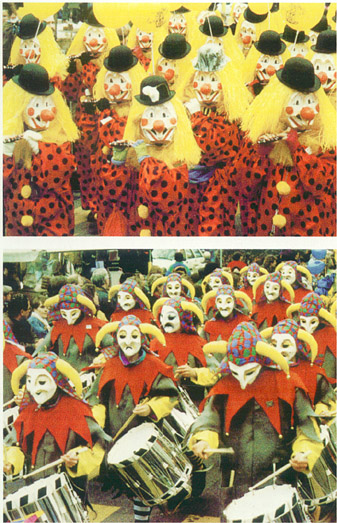 |
One day each February or March at four oíclock in the morning the city of Basel turns into a fife and drum Carnival. Companies of players like this in elaborate costumes and masks march through the streets for a three-day celebration of Fasnacht. Iíve never seen it but it sounds like my idea of fun. |
|
The Basel piccolo they play is a modern instrument, and was only recently brought into the Fasnacht celebrations, as youíll see towards the end of the | 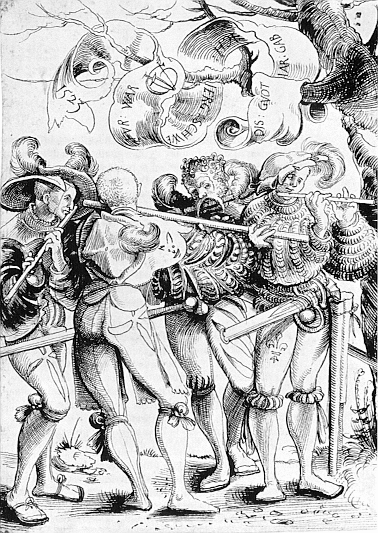 |
|
These guys were quite clearly off-duty when their picture was taken, and now hereís another group of players, in an unusual situation: they are playing on horseback, usually reserved for trumpets and kettledrums while fifes and drums slogged along the ground with the infantry. This in any case is an imaginary ceremonial setting conceived in about 1512 for Hans Burgkmairís Triumph of Maximilian I. The man with the banner is the Emperorís personal fifer, Anthony of Dornstštt, who accompanied him everywhere it seems. |
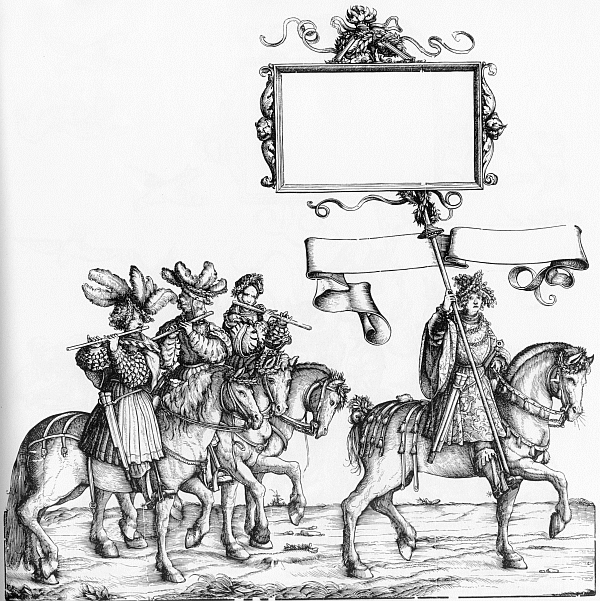 |
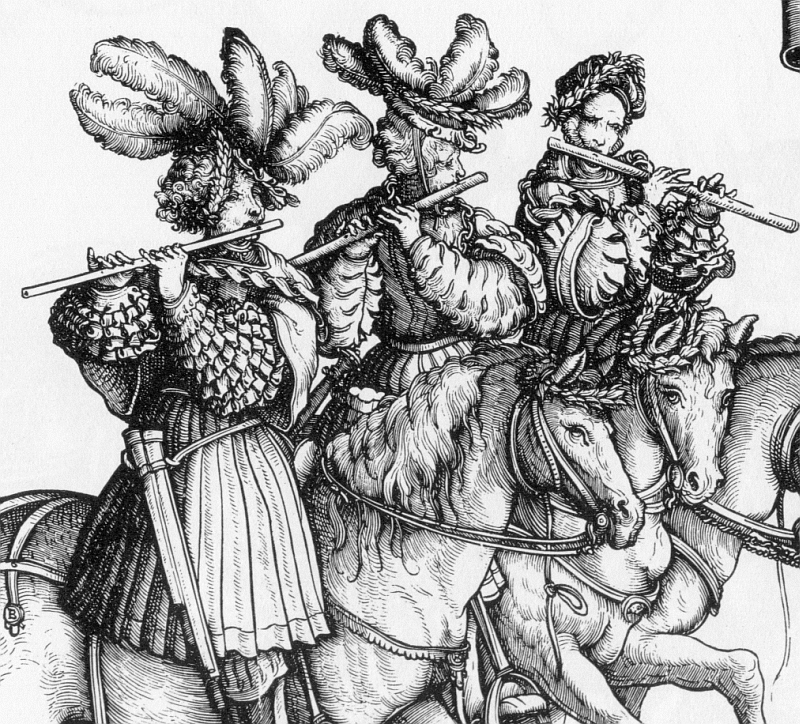
You see that the nearest fifer has a case for at least three sizes of instrument, but all three men appear to be playing instruments of the same length. They donít have their fingers tucked under because they need them to cover a fourth fingerhole for each hand, so there are eight in all on each of the flutes. Another woodcut by Burgkmair, in Der Weisskunig, the one with the emperor surrounded by his musicans and their instruments, shows a flute with seven holes. And there are other images of fifes with more than six fingerholes by artists such as Breughel the Elder (1528-1569) which thereís no time to go into now.
In any case, no matter how many holes thay may have had, these instruments of ceremonial and consort use seem to be exceptional. Fifes were used on the battlefield in a quite different way from the settings weíve seen so far. Hereís an illustration of about 1485, which is confirmed by written descriptions, showing how a fife and drum were used for signalling. At two important battles in 1476, Swiss infantry squadrons won famous victories using a highly trained formation bristling with nasty sharp things on long poles. Inside the formation were other men shooting out projectiles from crossbows and firearms, as well as one man playing a flute and another a drum. All the troops stepped in time to the fife and drumís beat, and you can see in the picture that the flute and drum are prominently shown and all the soldiers are on the same foot.
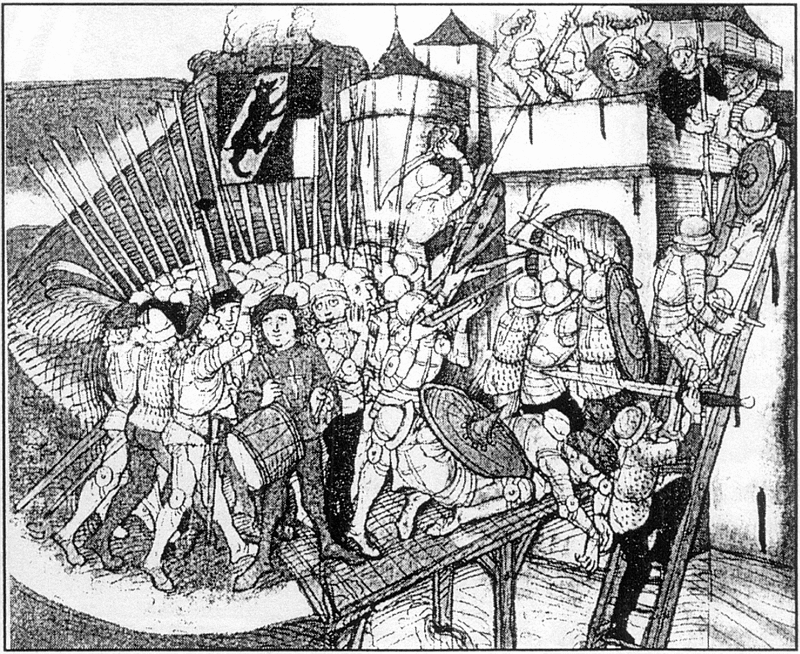
Once the Swiss infantry had use these effective and disciplined tactics to defeat the supposedly invincible Burgundian heavy cavalry in the 1470s they were soon hired out as mercenaries to teach first the German and French, then Spanish and Italian forces, and the fife and drum signals went with them. For example in 1494 the French military provisioning department was making payments to tambourins suisses, and shortly thereafter the French king established his own fife and drum corps, the phiffres et tabourins.
Now, although the men in the infantry formations stood and marched close together, the sounds of the military flute must have been extremely penetrating to be audible in a battle situation. We might immediately think of the fife we have heard in bands consisting of the Basel piccolo, or in the U.S. and Canada, of the shrill little colonial era instruments. The first mention of this instrument Iíve come across is by Thoinot Arbeau, who wrote in his dance manual Orchesographie of 1589 that the fife was Ďa little transverse flute with six holes, used by the Germans and the Swiss, and, as the bore is very narrow, only the thickness of a pistol bullet, it has a shrill note.í He also noted that the fife was played with extremely large drums, two and a half feet in diameter.
|
The drums Praetorius illustrated in 1619 were 2 feet in diameter, which is still very large for a side drum, and in fact bigger than even the bass drums normally used in marching bands today. They had a heavy snare on the lower head and a black spot on the batter head, which may have been to help the drum produce a tunable ringing tone. Praetoriusís Schweitzer Pfeiffen (at number 3) have sounding lengths of 10 inches and 1 foot. |
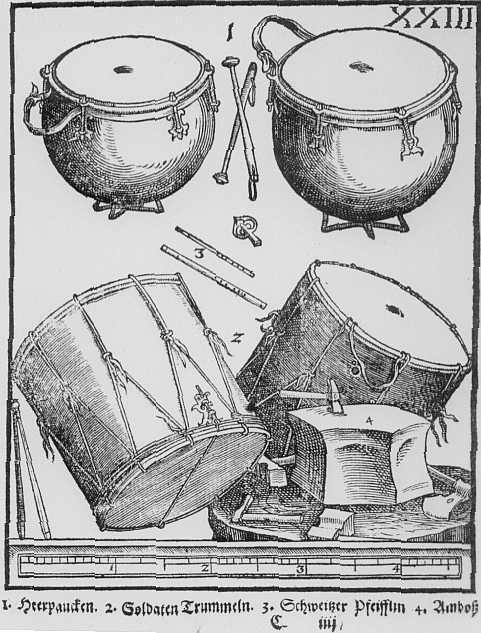 |
But that was already at the end of the sixteenth century, and according to the pictures made in earlier decades, military flutes seem to have been quite different from the modern fife. For one thing they were about twice as long.
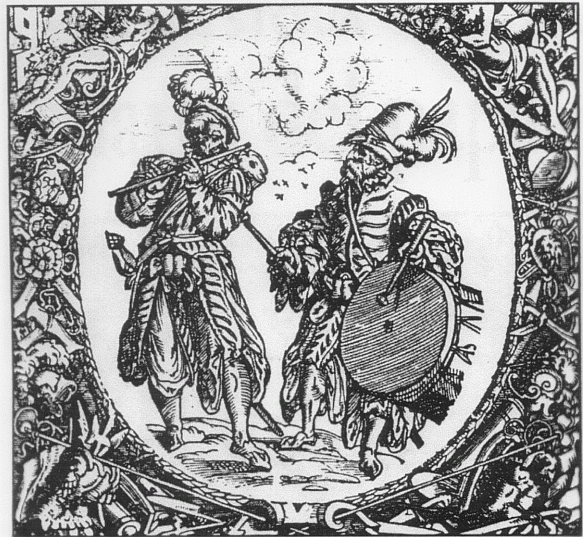 |
This woodcut by Jost Amman from the mid-16th century shows Landsknechte, German mercenaries who imitated the Swiss infantry. The flute is about two feet long and the drum is maybe a few inches larger. See that the fifer has a case slung over his left shoulder to hold several instruments. And his left little finger is tucked under the flute. |
In this and the next four slides I want to draw your attention not only to the length of the flute but to the position of the playersí hands, which are widely spaced so that the left hand seems too high up the tube.† Specifically, it seems that the players have their right third finger at a point at or near the middle of the tube, near where the first finger goes on a normal flute. We canít be sure of course that any one of these is an accurate representation of what the artist actually saw--and in fact this slide and the next one could well have been composed from a common model. But there is a certain consitency here and as I hope youíll see, it isnít completely implausible.
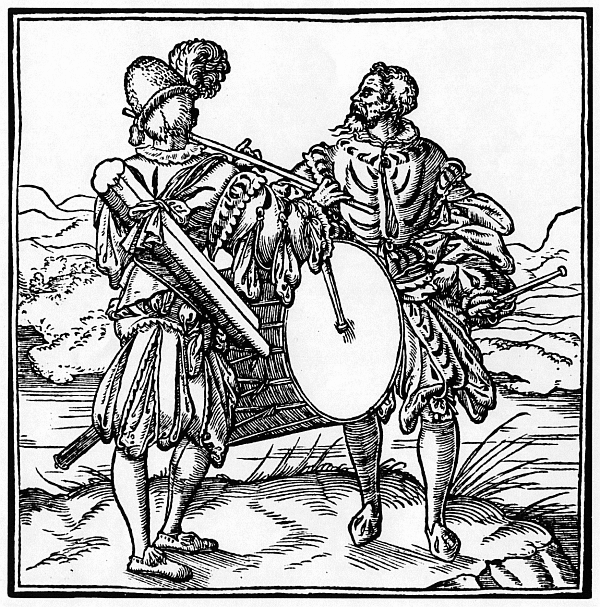 |
This anonymous woodcut from a German manual of military discipline published in 1555 shows a better view of a fifer with a case for four instruments slung over his shoulder. Again thereís the very large drum, and a long, narrow flute, and again his right little finger is tucked under. In this image you can clearly see the very wide hand spacing. |
|
This is another woodcut by Amman, dated 1568, showing a flute of similar proportions being played with other instruments, and with that same very strange-looking hand spacing.Though the men are soldiers thereís no drum involved here. A number of contemporary illustrations of dance bands show this type of flute mixed with other wind instruments. |
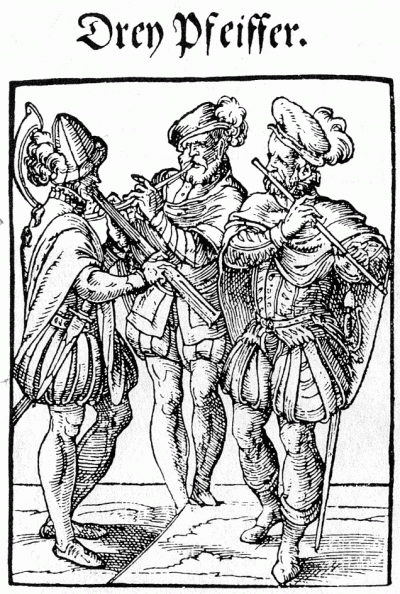 |
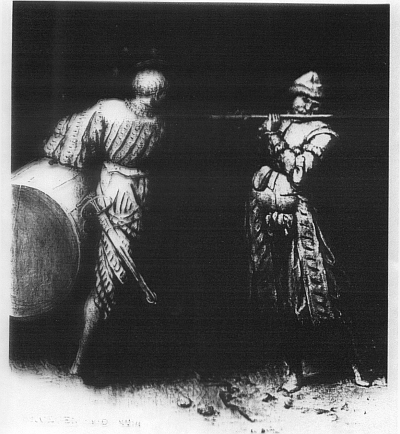 |
Hereís a painting by Breughel the Elder, The Three Soldiers, c1568 (New York: Frick Collection 65.1.163) Sorry for the terrible reproduction--you canít even see that thereís a third figure raising a banner between the two musicians. Iím showing it so you can see that this artist too illustrated the wide hand spacing on a two-foot fife and the absolutely huge field drum with a snare on the lower head.† |
|
To add to Swiss, German and Flemish sources, here we have a French one that shows two flutes played together with four large drums. Perhaps these are the tambourins Suisses of the French court establishment. |
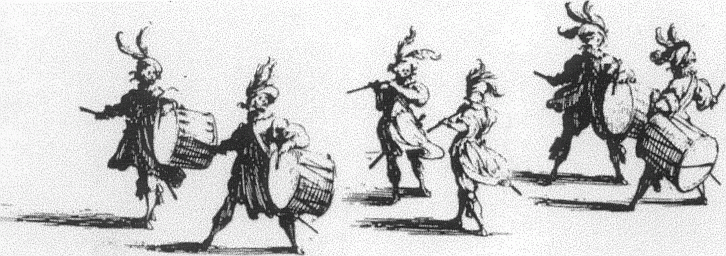 |
All right, if these military flutes were two feet long and had oddly-spaced fingerholes, what might they have sounded like?
To perform their function effectively in battle they must obviously have played clearly understood musical signals, but the signals first recorded are of no help since they came in the Swiss federal drum ordinances as late as 1819. Signalling aside, only one 16th-century source tells us much about what sort of music the military flute played. Arbeau wrote that: ĎThose who play improvise to please themselves and it suffices for them to keep time with the sound of the drum,í The examples he gives of fife improvisation style consist mostly of diatonic† noodling, I canít think what else to call them.
†In one of a very useful series of article in the SIFTS Bulletin Luca Verzulli has listed several transcriptions of fife improvisation for other instruments, such as keyboard, that go one better than Arbeau by including a notated part for the drum. Dominik Muehle† is going to join me to play one of these, a movement from Heinrich Ignaz Franz Biberís Battalia ŗ 10 (1673), a wonderfully crazy descriptive piece for strings and continuo. A section of the Battalia entitled ĎDer Marsí is scored for violin and double bass with a piece of paper between the strings to sound like a snare drum. Weíre going to play on my reconstruction of the flute shown in Fronspergerís engraving of 1555, and a drum that Liane kindly lent for the occasion . . .
A little about the flute. Because of its peculiar hole spacing, its fingering is not diatonic, like a shawm, but harmonic, like a tabor pipe or a trombone. It overblows at the 12th, and the first 11 notes can be played using only the lowest three holes.
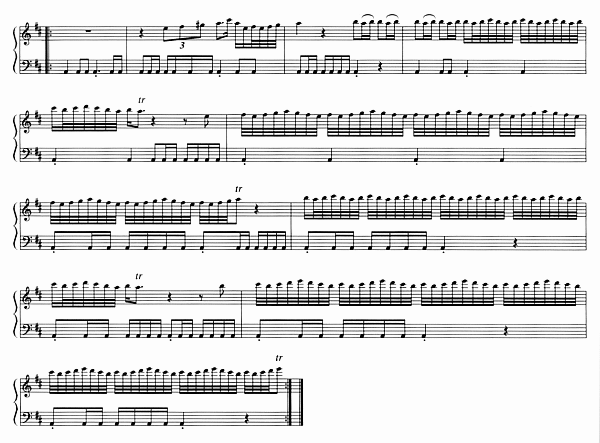
Now Iím not of course suggesting that all 16C military flutes worked this way, or even that any of them did: the flute Iím using is only what I think is a plausible interpretation of the pictures Iíve been showing, which represent only a selection of those that exist. Actually I donít believe there was any standardization in instruments or playing practice, in fact as I suggested there seems to have been quite a variety in fingering between different types of instrument. What seems clear though is that not all transversely held woodwind instruments of the sixteenth century were the same kind as the flutes we use for playing consort music.†
It also seems clear, though there hasnít been time to go into this, that we have the Swiss infantry to thank that the flute ever came into use for playing consort music at all. During the early fifteenth century it looks as though the flute was on its way out as an instrument for art music.† The Swiss soldiers, their signals, and their improvising put it back on the map in time to become one of the most popular instruments of the musical renaissance. Without them we would have no Basel piccolo--and no Renaissance Flute Days.